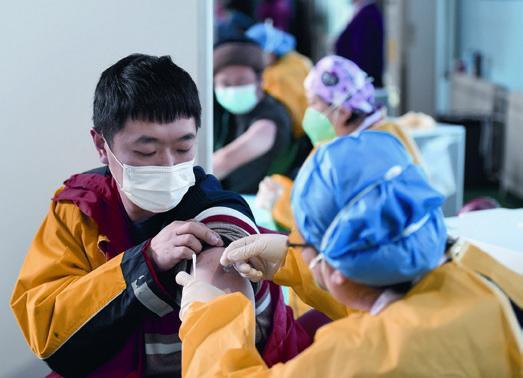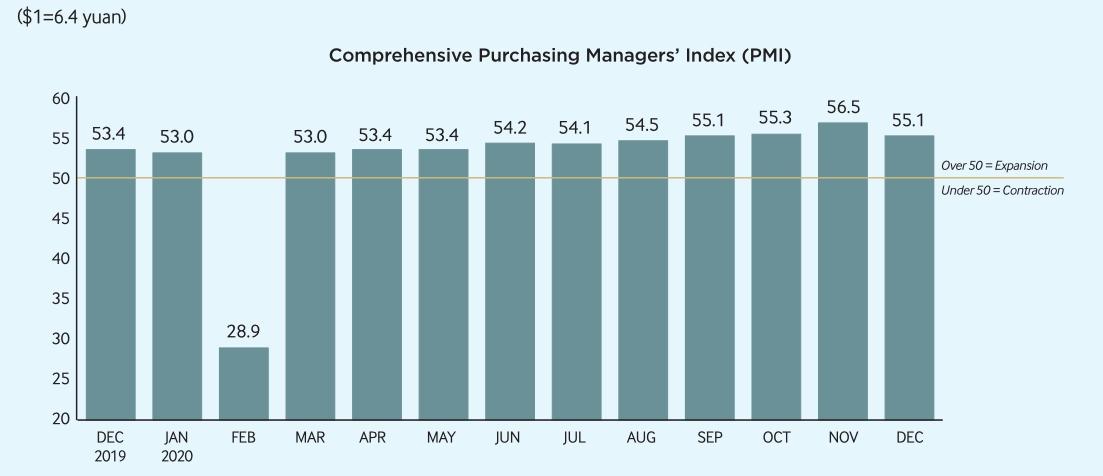VACCINATION STARTS AMONG KEY GROUPS
2021-01-19

A medical worker administers a novel coronavirus disease (COVID-19) vaccine to a delivery man at a temporary vaccination site in Haidian District, Beijing, on January 6. Beijing started distributing COVID-19 vaccines among specific groups of people with high infection risks after January 1.
Nine groups of people, aged 18 to 59, are scheduled to receive the vaccine before the Spring Festival of 2021, which falls on February 12. These key groups include frontline customs inspectors of imported cold chain goods and personnel working in the overseas and domestic transportation sectors.

Bridge in Clouds
An aerial photo of the Heshandu Wujiang River Bridge in Guizhou Province, southwest China, on December 29, 2020. The bridge, spanning 2,000 meters, is a key part of the Meitan-Shiqian Expressway. It was completed on January 3 and will open to traffic in July.
Telescope Sharing
Chinas Five-hundred-meter Aperture Spherical Radio Telescope(FAST), the worlds largest single-dish radio telescope, will be available for global service from April 1.
The National Astronomical Observatories of China (NAOC) of the Chinese Academy of Sciences, the operator of the telescope, confirmed on January 4 that scientists across the world can make online appointments to use the device for observational purposes starting from April 1. An allotted timetable will be available by August 1.
Jiang Peng, chief engineer of FAST with NAOC, said in the first year of the telescopes opening to the global scientific community, about 10 percent of observation time will be assigned to foreign scientists.
Located in a deep and round karst depression in Guizhou Province, southwest China, FAST is believed to be the worlds most sensitive radio telescope. It formally came into operation on January 11, 2020.
New Landmark
Shanghai plans to construct a new landmark, a 480-meter-tall building on the extended shoreline of the Bund, Xinhua News Agency reported on January 3.
The new block will be the highest on the west bank of the Huangpu River. The tallest building in Shanghai, and in China at large, however, is the 632-meter-tall Shanghai Tower standing on the east bank of the Huangpu River.
The new building on the west of the Huangpu River and north of the Suzhou River is designed for commercial purposes and office use with an above-ground floor area of some 350,000 square meters.
The building will drive the development of high-end industries and be home to the headquarters of multiple global enterprises.
Carbon Emissions
China will beef up efforts to cut carbon emissions in the industrial sector and roll out plans for key sectors to reach a peak in carbon emissions, an official said on January 4.
Efforts will be made to strictly control new production capacities within the heavy and chemical industries, and to cut the output of crude steel to ensure a year-on-year drop, Minister of Industry and Information Technology Xiao Yaqing said in an interview.
China has put in place a green manufacturing system, with 2,121 green factories and 171 green industrial parks built in the past five years.
The country will encourage industrial firms and parks to build green microgrids and prioritize the use of renewable energies, according to Xiao.
China previously announced that it will strive to peak carbon dioxide emissions by 2030 and achieve carbon neutrality by 2060.
All efforts now go into the formulation of a roadmap for the auto sector to meet these goals, to promote the development of electric vehicles, and to boost the recycling of batteries for new energy vehicles, the minister concluded.
Frosty Tourism
Chinese tourists are expected to make 230 million trips featuring ice and snow during the current winter season, a report released by the China Tourism Academy said on January 5.
According to the report, the current ice-and-snow tourism season, running from November 2020 into March 2021, is expected to generate more than 390 billion yuan ($60 billion) in revenue.
Chinas ice-and-snow tourism business was hit hard by the epidemic. During the season from November 2019 to March 2020, the number of trips shrank by 130 million, resulting in a lost revenue worth 240 billion yuan ($37 billion), compared with the previous season.
However, the report indicates that the peoples support for the winter travel industry is on the rebound, with more than half of the interviewees saying they will maintain or even increase their budget for such trips.
Investment in ice-and-snow tourism expanded during the last three years, with the total volume reaching 900 billion yuan ($139 billion).

A Learning Spree
Tourists have fun at the snow-covered Xiannushan National Forest Park in Chongqing, southwest China, on January 2.
Cleaner Air
Beijing saw more days with good air quality and a record-low average PM2.5 density in 2020, the municipal environment authorities announced on January 4.
The average concentration of PM2.5 in the metropolis was 38 micrograms per cubic meter in 2020, a year-on-year decline of 9.5 percent and the lowest measurement since the first data collection in 2013, according to the Beijing Municipal Ecology and Environment Bureau.
The PM2.5 reading is a gauge monitoring airborne particles of 2.5 microns or less in diameter, which can penetrate deep into the lungs.
Liu Baoxian, Director of the Beijing Municipal Ecological and Environmental Monitoring Center, said that half of Beijings 16 districts saw their PM2.5 density meet the national standard last year, up from only two in 2019.
In 2020, the city saw 276 days with good air quality (determined by the concentration of major air pollutants), up by 100 days from 2013, according to Liu.
However, experts say the BeijingTianjin-Hebei region and the nearby areas now face the arduous task of further improving air quality as the regions air pollutant emission still exceeds its environmental capacity.
Bullet Train
Fuxing bullet trains will run across Tibet Autonomous Region in southwest China for the first time in June when a new rail line opens, Chinas railway operator said on January 4.
With the launch of the service, the Fuxing bullet train series will be available in all provincial-level regions on the Chinese mainland, the China State Railway Group Co. Ltd. said.
Track-laying work for the rail line connecting regional capital Lhasa and Nyingchi in eastern Tibet was completed on December 31, 2020. It will be the first electrified railroad in Tibet.

Epidemic-Hit City
Pedestrians in Hong Kong wear masks on January 2. The city reported 35 cases of the novel coronavirus disease on that day.
Climate Study
Climate change could lead to more cryospheric hazards, posing extensive threats to society, states a recent study from Chinese researchers, Xinhua News Agency reported on January 5.
The cryosphere mainly refers to glaciers, permafrost, snow cover and sea ice as these components are continuously distributed below the freezing point with a certain thickness.
Storing more than 70 percent of the worlds freshwater resources, the cryosphere plays an important role in supporting key elements of the Earths natural structure for life, such as water resources, energy, and food security.
These components are sensitive to climate warming, and changes in the cryosphere can lead to serious hazards affecting society. Though the threats attract much public attention, there is as of yet no synthetic review available addressing the changes in cryospheric hazards of the past decades.
Results of the study have been published in the academic journal Earth-Science Reviews.
Holiday Consumption
The consumer market remained buoyant during the three-day New Year holiday, with the average daily sales of key retail enterprises up 6.2 percent year on year, the Ministry of Commerce said on January 4.
The companies saw sales of food, clothes, home appliances and digital products, as well as jewelry rise by 3.5 percent, 22.8 percent, 9.9 percent and 10.3 percent, respectively.
Sales at seven duty-free stores in the southernmost Hainan Province soared 213 percent from a year earlier.
Service consumption also picked up, with takeout transactions jumping 17 percent year on year in Beijing, the ministry said.
Bank Support
The China Banking and Insurance Regulatory Commission released a guideline on January 5, urging major initiating banks to replenish capital for rural banks and help them manage non-performing loans.
While calling for efforts to advance the reform and restructuring of rural banks, the guideline encouraged qualified strategic investors to offer help in purchases and capital increases.
To mitigate the mounting risks for some rural banks, the commission required local regulators to tailor risk management measures and stressed initiating banksresponsibilities.
It also pledged to guide financial institutions and non-financial firms to participate in the reform and restructuring of rural banks.
China had established 1,641 rural banks covering 71.2 percent of all county-level regions by the end of last September, the guideline said.
NEV Subsidy Cut
Subsidies for new-energy vehicles(NEVs) were reduced on January 1 as part of the governments efforts to promote the healthy development of the industry.
Subsidies for NEVs in public transportation, environmental sanitation, postal services and logistics and civil aviation airports, among others, were slashed by 10 percent compared to 2020. Other NEVs saw a reduction of 20 percent.
According to an earlier circular from the Ministry of Finance, the country will prevent over-expansion of NEV manufacturing.
In November 2020, a development plan for the NEV industry in 2021-35 was released. It said the proportion of NEVs in the sales of new vehicles is expected to rise to 20 percent by 2025, and vehicles used in public transportation will be completely electrified by 2035.
With the worlds largest inventory of NEVs, China accounts for 55 percent of global NEV sales.
NUMBERS


Logistics Data
The logistics sector sustained steady expansion in December 2020, despite a slight slowdown from the previous month, the China Federation of Logistics and Purchasing said on January 4.
The logistics performance index, which tracks business volumes, new orders, employment, inventory turnover, and equipment utility rates in the sector, came in at 56.9 percent in December 2020, down by 0.6 percentage point from November of the year.
A reading above 50 percent indicates expansion and below that mark, contraction.
With the Chinese New Year(February 12 in 2021) approaching, the logistics sector saw a seasonal contraction and the logistics performance index fell back accordingly, He Hui, Director of the China Logistics Information Center, said.
The sub-index for gross business volumes went down 0.6 percentage point to 56.9 percent, indicating business activities were less active. The sub-index for equipment utility rates lost 1.1 percentage points to 55.2 percent.
The sub-index for new orders stood at 55.8 percent, while that for business activity expectation was 53.4 percent, revealing enterprisesconfidence in the market.
Negative List
A new negative list for foreign investment access in the Hainan Free Trade Port in south China was unveiled on December 31, 2020. It will come into effect on February 1.
The 27-item list, jointly released by the National Development and Reform Commission and the Ministry of Commerce, introduces measures to promote opening up in crucial areas, such as valueadded telecommunication services and education, and to ease market access in the manufacturing and mining industries.
Restrictions on foreign investment access to online data processing and online transaction processing businesses will no longer apply when the list takes effect.
Prestigious overseas universities and vocational colleges specializing in science and engineering, agriculture, and medicine will be allowed to run on the island independently.
Foreign ownership limits for passenger car manufacturing will be lifted. Regulations prohibiting foreign investment in the exploration, mining and ore dressing of rare earth, radioactive minerals and tungsten will be repealed either.
E-Voucher Sales
Beijing distributed 39 million evouchers during a seven-month campaign in 2020 to spur consumption dampened by the coronavirus epidemic, according to local authorities on January 5.
The coupons, offered via online platforms such as JD.com and Meituan, helped generate sales volume totaling 13.52 billion yuan($2.1 billion), the Beijing Municipal Commerce Bureau said.
The campaign started last June after the epidemic had been largely contained. More than 1,000 activities covering catering, shopping, culture, tourism, entertainment, education, sports, fitness and other sectors were organized during that period to boost consumption.
An online live-streaming contest was also held, attracting over 300 companies to participate.
Rail Hubs
A record number of 9,679 inbound and outbound China-Europe freight trains passed through Xinjiang Uygur Autonomous Region, northwest China, in 2020, according to China Railway Urumqi Group Co. Ltd. on January 2.
The number of trains traveling through Alataw Pass reached 5,027 last year, up 41.8 percent year on year, while those through Horgos Port totaled 4,652, up 37 percent.
The company said a large quantity of goods previously transported to Europe via air and sea shifted to the China-Europe freight train service last year.
Local railway authorities expanded the capacity of the Alataw Pass and the Horgos Port in 2020. Through better coordination among railway, customs and border control authorities as well as with Kazak authorities, the time a train needed to pass the border was reduced to less than one hour from 10 hours, according to the company.
Currently, 22 lines run through Alataw Pass, reaching 13 countries including Germany and Poland, and 16 lines travel through Horgos Port to over 10 countries including Uzbekistan.
Power Generation
The Three Gorges Hydroelectric Power Station on the Yangtze River generated 111.8 billion kWh of electricity in 2020.
It beat the previous world record for hydropower generation of 103.098 billion kWh set by Brazils Itaipu plant in 2016.
The clean energy produced by the Three Gorges project in 2020 is estimated to be equivalent to saving about 34.39 million tons of standard coal equivalent and reducing the emissions of carbon dioxide by 94.02 million tons.
With 34 hydropower turbogenerators, the Three Gorges project has a generating capacity of 22.5 million kw.
